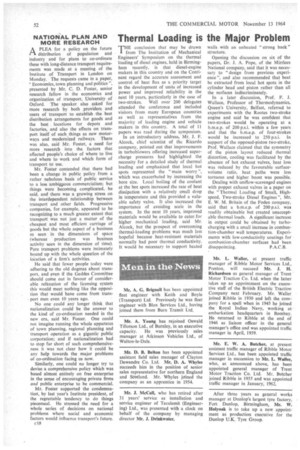Thermal Loading is the Major Problem
Page 54

If you've noticed an error in this article please click here to report it so we can fix it.
THE conclusion that may be drawn from The Institution of Mechanical Engineers' Symposium on the thermal loading of diesel engines, held in Birmingham recently, is that diesel-engine makers in this country and on the Continent regard the accurate assessment and control of heat flux as a priority target in the development of units of increased power and improved reliability in the next 10 years, particularly in the case of two-strokes. Well over 200 delegates attended the conference and included visitors from many European countries as well as representatives from the majority of leading engine and vehicle makers in this country. A total of 11 papers was read during the symposium.
In an introductory address, Mr. J. F. Alcock, chief scientist of the Ricardo company, pointed out that improvements in turboblowers offering increased supercharge pressures had highlighted the necessity for a detailed study of thermal loading and emphasized that local hot spots represented the "main worry which was exacerbated by increasing the bore size. Local boiling of the coolant at the hot spots increased the rate of heat dissipation with a relatively small drop in temperature and this provided a valuable safety valve, It also increased the importance of avoiding scale in the system. In the next 10 years, improved materials would be available to cater...for higher mechanical loading, said Mr. Alcoa, but the prospect of overcoming thermal-loading problems was much less hopeful because heat-resistant materials normally had poor thermal conductivity. It would be necessary to support heated walls with an unheated "strong back" structure.
Opening the discussion on six of the papers, Dr. J. A. Pope, of the Mirrlees National company, said that it was necessary to "design from previous experience", and also recommended that heat be extracted from local hot spots in the cylinder head and piston rather than all the surfaces indiscriminately.
In a later discussion, Prof. F. J. Wallace, Professor of Thermodynamics, Queen's University, Belfast, referred to experiments with the Rootes two-stroke engine and said he was confident that two-strokes would be operating at a b.m.e.p. of 200 p.s.i. within a few years and that the b.m.e.p. of four-strokes would be increased to 250 p.s.i. In support of the opposed-piston two-stroke, Prof. Wallace claimed that the symmetry of the piston layout reduced thermal distortion, cooling was facilitated by the absence of hot exhaust valves, heat loss was reduced by the favourable surfacevolume ratio, heat paths were less tortuous and higher boost was possible.
Dealing with unit:low-scavenged engines with poppet exhaust valves in a paper on the "Thermal Loading of Small, Highspeed, Two-stroke Diesel Engines", Mr. E. W. M, Britain of the Foden company, said that a b.m.e.p. of 200 p.s.i. was readily obtainable but created unacceptable thermal loads. A significant increase in output could be obtained by turbocharging with a small increase in combustion-chamber wall temperatures. Experiments with low-conductivity coatings for combustion-chamber surfaces had been
disa ppoin Ling. P.A.C.B.
























































































































